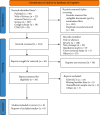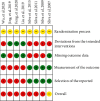Medicine Insufficient Evidence for the Efficacy of Massage as Intervention for Autism Spectrum Disorder: A Systematic Review
- PMID: 36193150
- PMCID: PMC9526643
- DOI: 10.1155/2022/5328320
Medicine Insufficient Evidence for the Efficacy of Massage as Intervention for Autism Spectrum Disorder: A Systematic Review
Abstract
The efficacy of massage therapy in the treatment of children with autism spectrum disorder (ASD) remains unclear. This study systematically reviewed the impact of massage therapy on children with ASD according to the preferred reporting items for systematic reviews and meta-analyses (PRISMA) declaration guidelines. A literature search of the PubMed, Web of Science, Science Direct, Scopus, Google Scholar, and China National Knowledge Infrastructure (CNKI) electronic databases from inception to December 20, 2020, was conducted using the term "autistic/autism" along with one of the following terms, "massages," and "Tui na." The risk of bias was assessed using the Cochrane risk of bias Tool. Eight randomized controlled trials examining the impact of massage on children with ASD were included. Interventions combining Qigong massage or Tui na with the control group treatments from once a day to twice a week, for a duration of 15-30 mins, and lasting for six weeks to five months were the main interventions. All reviewed studies reported significant improvement in children with ASD who received massage, especially in the sensory domain, and that massage in combination with control treatment was superior to control treatment alone. However, the overall quality of the available studies is poor with a high degree of heterogeneity. The majority of studies showed a high risk of bias with poor study design, inconsistency in massage protocols, and subjective outcome measures. Assessment bias was a common weakness of these studies. Therefore, there is insufficient evidence to conclude that massage is effective for ASD. Future studies should include large sample sizes, incorporate double-blind designs, employ appropriate outcome measures, and allow for long observation and follow-up periods. Furthermore, consensus must be reached on standardized treatments and additional therapies in order to provide better quality evidence for the treatment of ASD.
Copyright © 2022 Hui Ruan et al.
Conflict of interest statement
The authors declare that they have no conflicts of interest.
Figures
Similar articles
-
Effects of Massage on Self-regulatory Difficulties, Tactile and Oral Abnormalities, and Parenting Stress in Children with Autism Spectrum Disorder (ASD): A Systematic Review and Meta-analysis.Int J Ther Massage Bodywork. 2024 Dec 12;17(4):4-19. doi: 10.3822/ijtmb.v17i4.1079. eCollection 2024 Dec. Int J Ther Massage Bodywork. 2024. PMID: 39669546 Free PMC article.
-
The future of Cochrane Neonatal.Early Hum Dev. 2020 Nov;150:105191. doi: 10.1016/j.earlhumdev.2020.105191. Epub 2020 Sep 12. Early Hum Dev. 2020. PMID: 33036834
-
Communication interventions for autism spectrum disorder in minimally verbal children.Cochrane Database Syst Rev. 2018 Nov 5;11(11):CD012324. doi: 10.1002/14651858.CD012324.pub2. Cochrane Database Syst Rev. 2018. PMID: 30395694 Free PMC article.
-
Qigong in the treatment of children with autism spectrum disorder: A systematic review.J Integr Med. 2019 Jul;17(4):250-260. doi: 10.1016/j.joim.2019.04.003. Epub 2019 Apr 19. J Integr Med. 2019. PMID: 31053555
-
Evaluating the efficacy of Tui Na in treatment of childhood anorexia: a meta-analysis.Altern Ther Health Med. 2014 Sep-Oct;20(5):45-52. Altern Ther Health Med. 2014. PMID: 25141371
Cited by
-
Use of complementary and alternative medicine in children affected by oncologic, neurologic and liver diseases: a narrative review.Ital J Pediatr. 2023 Nov 15;49(1):152. doi: 10.1186/s13052-023-01554-0. Ital J Pediatr. 2023. PMID: 37968663 Free PMC article. Review.
-
Effects of Parent-Delivered Traditional Thai Massage on Gait and Heart Rate Variability in Children with Autism: A Randomized Controlled Trial.J Integr Complement Med. 2024 Mar;30(3):269-278. doi: 10.1089/jicm.2023.0338. Epub 2023 Sep 15. J Integr Complement Med. 2024. PMID: 37713302 Free PMC article. Clinical Trial.
-
Effects of Massage on Self-regulatory Difficulties, Tactile and Oral Abnormalities, and Parenting Stress in Children with Autism Spectrum Disorder (ASD): A Systematic Review and Meta-analysis.Int J Ther Massage Bodywork. 2024 Dec 12;17(4):4-19. doi: 10.3822/ijtmb.v17i4.1079. eCollection 2024 Dec. Int J Ther Massage Bodywork. 2024. PMID: 39669546 Free PMC article.
References
-
- CDC. ADDM Network Community Report on Autism . Atlanta, GL, USA: Centers for Disease Control and Prevention; 2020.
-
- American Psychiatric Association. Diagnostic and Statistical Manual of Mental Disorders (DSM-5) VA, USA: American Psychiatric Association; 2013.
Publication types
LinkOut - more resources
Full Text Sources



